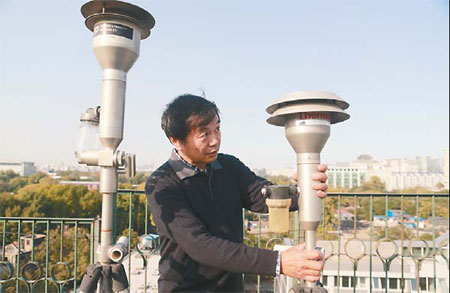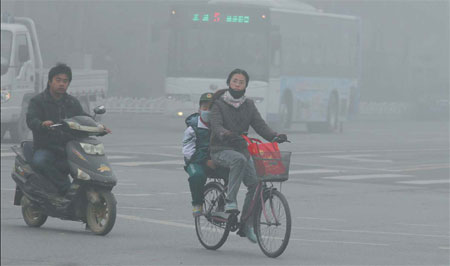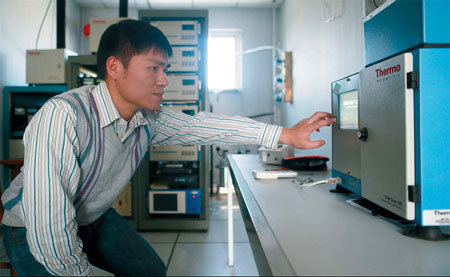Clearing away the fog of doubt
Updated: 2012-10-30 07:53
By Wu Wencong and Jiang Xueqing in Beijing, and Qiu Quanlin in Guangzhou (China Daily)
|
|||||||||
|
Yang Xiaoguang checks monitoring equipment in Beijing as part of measures to improve air quality. Feng Yongbin / China Daily |
|
A heavy haze covers Langfang, Hebei province. Experts say the main sources of air pollution in autumn and winter time are coal-fired power plants, heavy industry and diesel-powered automobiles. Zhu Xingxin / China Daily |
|
A staff member from the Dongcheng district's bureau of environmental protection in Beijing, checks a piece of equipment that tests PM2.5 at a monitoring station in downtown. Feng Yongbin / China Daily |
New monitoring systems will give a better indication of pollution, report Wu Wencong and Jiang Xueqing in Beijing, and Qiu Quanlin in Guangzhou.
While Friday's airborne pollution in Beijing became a hot topic on China's online social networks and in newspapers, the environmental authorities insisted they are taking measures to contain the problem.
"Beijing has finished framing regional measures to jointly prevent and control air pollution within Beijing, Tianjin and Hebei province," said Yu Jianhua, head of the atmospheric environment management office of the Beijing Environmental Protection Bureau.
According to the Beijing Municipal Environmental Monitoring Center on Friday, trial readings of PM2.5 - particulate matter smaller than 2.5 micrometers - from most of the city's 35 monitoring stations exceeded 300 micrograms per cubic meter. The readings hit level six, indicating the highest level of pollution, four times the national standard.
Medical experts say PM2.5s are responsible for a range of conditions: Short-term exposure can result in sore throats and coughs, while prolonged bouts are thought to contribute significantly to reduced lung function, coronary disease and premature deaths.
Official data suggest that about 25 percent of the capital's atmospheric pollutants blow into the city from nearby heavily industrialized regions.
Yu said the new measures are part of a long-term joint project among several regions to clean up air pollution nationwide. The project was established by the Ministry of Environmental Protection and details will be released by the end of the year. However, no date for implementation has been announced.
Few residents of China's larger cities are unfamiliar with air pollution, especially during autumn and winter, when low-hanging mist shrouds buildings in an impenetrable gray cloak.
In 2010, researchers Aaron van Donkelaar and Randall Martin of Dalhousie University in Canada used NASA satellites to create a map showing that the highest levels of PM2.5 occur across a belt of land stretching from North Africa, where desert winds disturb huge amounts of dust, to eastern China, a heavily industrialized region.
Since early October, Guangzhou, the capital of Guangdong province, has been covered by a pall of dust and haze.
The main sources of air pollution in cooler weather are coal-fired power plants, heavy industry and diesel-powered automobiles, according to experts.
"The effects of these sources are often worse in wintertime when pollutants are trapped near the ground because of poor vertical mixing," said Richard L. Corsi, a professor in the engineering department at the University of Texas who researches indoor air quality.
The weaker sunlight and lower temperatures near the ground, caused by fog in autumn and winter, keep pollutants trapped closer to the surface of the earth, he said.
Increased air travel
In addition to the weather, pollutants discharged at airports are also adding to the poor air quality, especially the prevailing haze over Guangzhou, according to Wu Dui, who lives in the city and specializes in haze research.
"The number of pollutants discharged by aircraft has risen in recent years, in line with the increased number of flights in the Pearl River Delta," he said.
Guangzhou's Baiyun Airport is one of the few in China capable of handling the world's largest passenger aircraft, the Airbus A380, which uses around 2 tons of fuels during take-off and landing. That's equal to the total emissions of more than 1,000 autos, said Wu.
As one of South China's most important manufacturing hubs, the Pearl River Delta has airports at Guangzhou, Shenzhen, Zhuhai, Zhanjiang, Foshan, Meizhou and Shantou. "There are just too many airports concentrated in a tiny region," said Wu.
Sources at Guangzhou Baiyun said the airport handled 183,400 aircraft arrivals and departures and more than 23.5 million passengers in the first half of the year. Both the sorties and passenger numbers rose by more than 7 percent from the same period a year ago.
"The smoggy days in the delta region will remain until April if there are no strong winds from the north to help disperse the haze and dust," said Wu.
Ventilation index
China's Internet users are fond of joking that clear air in the larger cities can only be expected after gale-force winds, but University of Texas' Corsi said reliance on strong air currents to "dilute" pollution is not unusual.
"There is a term, the 'ventilation index', which is wind speed multiplied by the height of the mixed layer, meaning the atmospheric height over which pollutants can be dispersed," he said. "High winds and high mixed layer height are generally good (conditions)."
However, he pointed out that popular fantasies of artificially made winds cleansing the air are "technologically impossible because of the very large amount of air that would have to be moved".
China's environmental agencies are already implementing methods to accelerate change, and Beijing has set a target of keeping the levels of PM2.5 below a recently established national standard by 2030, although experts said that will be a difficult task.
The new national air quality standard, unveiled by the Ministry of Environmental Protection in February, set the daily PM2.5 limit at 75 mcg per cu m, with an average annual ceiling of 35 mcg per cu m.
Officials from Beijing's environmental protection bureau have confirmed that 700,000 old motor vehicles will be banned from the city center by the end of 2015. Moreover, new standards for fuel, on a par with European Union limits, were adopted in May. Beijing's V emissions standard is expected to be unveiled by the end of the year.
The ministry has also ordered 74 cities to begin monitoring and releasing data about six types of pollutants, including PM2.5, from almost 500 national-level stations by the end of December.
Meanwhile, Guangzhou's environmental protection bureau said the city will establish a further 18 city-level PM2.5 monitoring stations by the end of the year.
The environmental departments in Beijing, Shanghai and Guangzhou monitor PM2.5 via a method called tapered element oscillating microbalance, which measures changes in the frequency of particle oscillation to calculate the weight of particles collected.
The US Embassy, which offers free public information on air quality in Beijing and Shanghai, uses a different method, which monitors the energy decay of beta rays to assess the concentration of particles in the atmosphere.
Although both are recognized as mainstream methods, the results obtained from beta ray measurements are usually at least 15 percent higher than those garnered by oscillating microbalance, according to data on the website of the China National Environmental Monitoring Center.
Emergency plan
While it is a good thing that more cities are now publishing their PM2.5 readings, the real challenge is not simply to measure airborne pollution, but to directly reduce the level of pollutants over the short term.
However, more information means people can check the readings from their closest monitoring station and take appropriate action, according to experts at the Beijing Municipal Environmental Monitoring Center.
If outdoor activity is unavoidable, specially designed masks may help block the tiny airborne particles, said Ma Yongliang, a researcher specializing in the prevention of air pollution prevention at Tsinghua University's School of the Environment.
Yu, from the Beijing Environmental Protection Bureau said that a plan for heavily polluted days is currently being formulated and will be released soon.
Chen Tian, the bureau head, told Beijing News that whenever circumstances require, the plan will be activated and physical education may be halted in primary and middle schools and the use of governmental cars in Beijing suspended.
Automobile exhaust contributes more than 20 percent of the capital's air pollution. In an attempt to reduce traffic levels and therefore emissions, Beijing's transportation bureau is assessing a plan to restrict car use in the city to alternate days, and to specific times in certain areas, depending on whether the final digit on the vehicle's license plate is odd or even, according to a report published on Oct 15.
The situation is a classic problem, one that the US, United Kingdom, and European countries faced 50 or more years ago, according to Corsi of the University of Texas.
He said those countries solved the problem by imposing strict controls on industry. "But it took one or two decades to really get everything under strict control. This type of change rarely happens overnight."
Contact the reporters at wuwencong@chinadaily.com.cn, jiangxueqing@chinadaily.com.cn and qiuquanlin@chinadaily.com.cn
(China Daily 10/30/2012 page6)

 Relief reaches isolated village
Relief reaches isolated village
 Rainfall poses new threats to quake-hit region
Rainfall poses new threats to quake-hit region
 Funerals begin for Boston bombing victims
Funerals begin for Boston bombing victims
 Quake takeaway from China's Air Force
Quake takeaway from China's Air Force
 Obama celebrates young inventors at science fair
Obama celebrates young inventors at science fair
 Earth Day marked around the world
Earth Day marked around the world
 Volunteer team helping students find sense of normalcy
Volunteer team helping students find sense of normalcy
 Ethnic groups quick to join rescue efforts
Ethnic groups quick to join rescue efforts
Most Viewed
Editor's Picks

|

|

|

|

|

|
Today's Top News
Health new priority for quake zone
Xi meets US top military officer
Japan's boats driven out of Diaoyu
China mulls online shopping legislation
Bird flu death toll rises to 22
Putin appoints new ambassador to China
Japanese ships blocked from Diaoyu Islands
Inspired by Guan, more Chinese pick up golf
US Weekly

|

|










